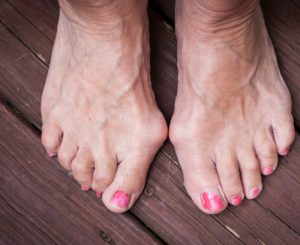Podiatrist may recommend nonsurgical foot treatments first
 Many times, I have patients come to AMA Podiatry because they were advised that surgery was the only way to fix their specific case.
Many times, I have patients come to AMA Podiatry because they were advised that surgery was the only way to fix their specific case.
In truth what they’re looking for is an end to their chronic pain as soon as possible. However, in most cases, surgery isn’t a simple “fix”. Often patient don’t consider that recovery time can be quite lengthy and may involve further risks of complications, or these complications can delay healing even further. And in some cases, surgeries (which are permanent) cause further issues and long-term effects.
AMA Podiatry has a high degree of success treating serious foot problems like plantar fasciitis, nerve pain and bunions using nonsurgical techniques.
Surgical intervention isn’t always the right answer
Often patients are informed they require bunion surgery. The procedure would require 8 weeks of rest, and surgical removal of bone from the foot.
An alternative consult from a specialist podiatrist would recommend a wider toe box with a straighter last. Once this is achieved, we can identify the Biomechanics that resulted in the bunion. Once the mechanics (bio mechanical) is understood, we can set about developing a treatment plan that may include custom orthotics, muscle strengthening and various therapies to reduce inflammation and pain.
Custom Orthotics
Most common patient issues are related to: plantar fasciitis, arch pain, flat feet, forefoot pain, corns, calluses, nerve pain, servers, heel spurs, hammer toes, morton’s neuroma, diabetic ulcers, knee pain and limb length discrepancy.
I choose to employ years of training and experience to formulate an individual treatment plan tailored for each patient. AMA Podiatry don’t automatically issue custom orthotics to every patient that we see. We work together with our extensive network of practitioners to identify the causes and mechanisms of your condition to formulate treatment plans.
Custom made orthotics are generally a first line treatment for foot pathologies like flat feet or high arches, which cause pressure build up over portions of the foot. Orthotics bring about change to a patient’s musculoskeletal conditions, ad balance to a patient walking gait and change the distribution of force of the feet. This then can also bring about change to ankles knees and back issues.
Combined therapies
Shockwave therapy
Issues: Plantar fasciitis, heel pain, tendinitis, shin splints.
An extracorporeal shockwave is defined as a non-evasive, non-electrical high energy sound wave that passes through the body via a hand-held probe. The shock waves produce a rapid increase in blood circulation to target area (foot or leg) and will break down fibrous scar tissue which builds up over time, especially with chronic conditions.
The break-down of scar tissue is the key to why shock wave therapy is so effective.
By increasing circulation and breaking-down scar tissue, shock wave therapy will stimulate cell regeneration and promote normal healing and rapid reduction of pain. Used in a combined application (3-6 visits) with orthotics we see a significant improvement in quality of life and pain reduction.
Laser Therapy
Issues: muscle/joint pain, stiffness and general arthritic issues.
Laser therapy directs pulsating photons of light energy (cold laser therapy) into the injured tissues to prompt faster healing, reduce pain and inflammation. The laser works on cells, ligaments, muscle and soft tissue alike.
Within ten minutes of treatment patients begin to experience relief. It is recommended that you may need multiple treatments (3-6) to achieve the full benefits of laser therapy. While most patients experience a high level of pain relief reduction after the first or second treatment, over 90% of patients report positive results after the third treatment. Once swelling is reduced, pain relief tends to progress rapidly.
Physical Therapy
Issues: everything
Although slower about 50% of foot issues can be improved with physical therapy and strength training with no need for surgical intervention. Gains are especially seen for Achilles tendon issues (where tendon isn’t torn) often the Achilles becomes strained when calf muscles are weak. By strengthening the entire leg, we create better force absorption and minimize future injuries. Some exercises involve TheraBand’s for resistance, while others like calf stretch, feet stretch, foam rolling, seated crawls, toe walking and arch raise work on stretching and strengthening.
More Information or Make a Booking
For more information on how we can help you, please call us on 9576 9495 or complete our enquiry form: Enquiry Form
